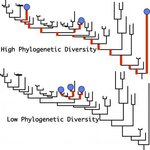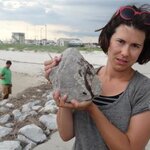Environment

Easy metrics like 'it takes a gallon of gas to make a pound of beef' or 'it takes 140 liters of water to make a cup of coffee' get mainstream media because they are outrageous. They are outrageous because they are completely wrong.
What is the 'real' cost of eating beef? Are the other animal or animal-derived foods better or worse?
A new method attempts to compare the environmental costs of various foods and the authors believe they came up with some surprisingly clear results. The team looked at the five main sources of protein in the American diet: dairy, beef, poultry, pork and eggs.…

Though there is a deluge of new information about the diversity and distribution of plants and animals around the globe, conservation efforts outside government science remain very firmly trapped in a 1980s world of fundraising and brochures and cultural name-calling.
But Big Data in a Science 2.0 environment could dramatically boost conservation efforts and biodiversity if it catches on.
A new model developed by University of California, Berkeley, biologist Brent Mishler and colleagues leverages Big Data – much of it from newly digitized museum collections – to help pinpoint the best…
Despite decades of concern about a looming population bomb and mass starvation, American agriculture has instead 'dematerialized' in a material world: using science, farmers are now feeding more people on less land than ever thought possible.
If science were similarly accepted in Europe and developing nations. we could easily feed 3 billion more people and still decrease agriculture's environmental footprint, according to a paper in Science.
The report by the University of Minnesota's Institute on the Environment focuses on 17 key crops that produce 86 percent of the world's crop…

The 2010 BP Deepwater Horizon spill in the Gulf of Mexico was, to-date, the largest accidental release of oil into the ocean. 210 million gallons issued from the blown-out well.
In an attempt to prevent vast quantities of oil from fouling beaches and marshes, BP applied 1.84 million gallons of the dispersant compound DOSS to oil released in the subsurface and to oil slicks at the sea surface. DOSS rapidly degrades in the environment but a new study by scientists at Haverford College and Woods Hole Oceanographic Institution (WHOI) found that though DOSS does decrease the size of oil…

For nearly four decades, some have suspected that persistent organic pollutants - a large group of man-made chemicals that, as their name indicates, persist in the environment - contributed to a green turtle's susceptibility to the virus that causes fibropapilomatosis, a disease that forms large benign tumors that can inhibit the animal's sight, mobility and feeding ability.
A new paper by researchers from the Hollings Marine Laboratory (HML) and university and federal collaborators in Hawaii demonstrated these man-made chemicals are not a co-factor linked to the increasing…

Crop spraying on British farms could be aiding a life-threatening fungus suffered by tens of thousand of people in the UK each year.
New research by British and Dutch scientists has found that Aspergillus – a common fungus that attacks the lungs and is found in soil and other organic matter – has become resistant to life - saving drugs in parts of rural Yorkshire.
It's the first time a link has been made in the UK between drug resistance in Aspergillus and fungicide used on crops. Experts warn their findings, now published, are significant and raise serious implications for transplant…

The fad du jour (and I defy you to find a non-du jour day) is something that sounds like an absolute win-win. It has all the correct buzzwords—green, sustainable, environmentally friendly, endocrine disruptors, bioaccumulation. And many more. Today it's buildings.
This is exactly what we at ACSH deal with every day in different forms. There is more than a passing similarity to the very successful promotion of organic foods, dietary supplements, and "chemical-free" (fill in the bank). This is because certain industries and trade groups take full advantage of the usual (but nonetheless…

Marine biologists at Plymouth University and the activist group WorldFish conducted analyses of catches over the past 90 years and found significant evidence of the practice of 'fishing down the food web' - removal of many top predators from the sea that has left fishermen 'scraping the barrel' for increasing amounts of shellfish.
Sharks, rays, cod, haddock and many other species at the head of the food chain are at historic lows with many removed from the area completely, they say.
The report used catch statistics from the International Council for the Exploration of the Seas to establish a…

It's not well known to urban environmentally conscious people but rural people know that deer are a lot like rats - they will eat everything if you don't stop them.
Because state forests are part of a political machine, various political lobbying has blocked biology and that led to an overabundance of deer and decades of damage.
But regulated deer hunts in Indiana state parks helped damaged forests recover nicely. The big win, found analysis of a 17-year-long Indiana Department of Natural Resources policy of organized hunts in state parks, was for native tree seedlings, herbs and wildflowers…

One way to scientifically optimize nature is to understand how soil moisture, the water contained within soil particles, behaves in Earth's water cycle.
Soil moisture is essential for plant life and influences weather and climate and now researchers working with data from NASA's Aquarius instrument have created worldwide maps of soil moisture, showing how the wetness of the land fluctuates with the seasons and weather phenomena.
Launched June 10, 2011 aboard the Argentinian satellite Satélite de Aplicaciones Científicas (SAC)-D, Aquarius was built to study the salt content of…